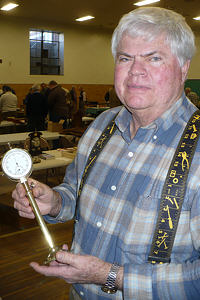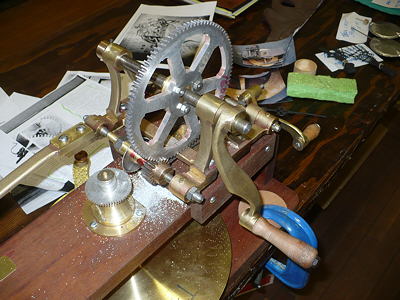Meetings PastNovember 20, 2010 Meeting Highlights November's well-attended mart featured a full complement of highly regarded vendors, well-stocked tables, and many wonderful bargains to be found. However, our chapter meetings are much more than opportunities to buy! A Hamilton 'Seckron' model 17j mechanical wrist watch, ca. 1935, once owned by a World War II bomber pilot who had perished during the war, graced the wrist of a proud descendent.When found, the watch suffered from unskilled repairs to its center wheel and was missing its crystal, but was amazingly otherwise in mint condition, including the black double dial and original hands.Thanks to the painstaking skill, steady hand, and resourcefulness of expert watch repairer, accomplished musician, and chapter member, Bruce Haynes, this rare watch is now restored and running beautifully. Chapter member Lydia Rufleth consulted fellow members George Bruno and Larry Byrne, both seasoned wood movement clock makers, regarding a project she has undertaken: that of replacing missing parts for an antique wooden tall clock movement in her collection. The photo accompanying this article shows Lydia holding her first "practice" count wheel (rendered in pine), while discussing additional, beautifully executed gears she made with Larry. We look forward to updates on her progress.
Attendees of November's chapter meeting took great delight in a presentation given by James Storrow, a native of Boston, now of Stormville, NY. For those of you who haven't yet had the pleasure of meeting James, he is a tower clock afficionado who occasionally appears at Chapter 84 meetings accompanied by his pet blue Amazon parrot. The subject of James' talk was the restoration of a tower clock made by Gawen Brown, dated 1766, in Old South Church, Boston, MA. The Brown clock is one of the three oldest extant tower clocks in this country to be running in their original locations. Presently a National Historic Landmark, Boston's Old South Congregational meetinghouse was built in 1729.As of 1766, American colonists had long been accumulating grievances against the crown, and revolution was brewing in the vicinity of Boston.Only one in 250 colonists owned a clock, so upon its installation, the tower clock at Old South Church literally became the focal point of Bostonian civic (and revolutionary) activity. Although Old South Church's tower was built to hold three clock dials, it never actually received more than two, most recently, ca. 1880. The clock's time and strike movement had not run since 1870, and was very dirty. James assisted horologist David Hochstrasser in disassembling and reassembling the clock for cleaning and repairs. One of the clock's 9' diameter dials was found to be beyond repair; it was reproduced from mahogany. The second dial was repainted and reused. New numerals for both dials were cast. These were coated with a double layer of gold leaf. The dials' velvet-like black ground was achieved using colored sand over wet paint, a technique known as "smalt". The clock has an 88" pendulum length and a crudely cast, hollow iron "cannonball" bob; count wheel strike; an iron frame; brass gears; steel arbors; and wooden winding drums. It features a simple form of maintaining power, which allows the clock to run for about 5 min. while being wound. Dots punched at the roots of the gear teeth support an argument that the teeth were filed entirely by hand. James' presentation included primary historical documents related to the clock, which is presently not set up to strike the hours because of the lack of a suitable bell. During the course of his talk, James managed to infect us with his hope of obtaining one of Paul Revere's original bells for the tower--an appropriate, but as yet very much uncertain, outcome for the Old South Church tower clock's story. Our thanks to James for the many uplifting thoughts and ideas he shared with us Nov. 20. Thanks, also, to all the wonderful volunteers who made our chapter meetings happen in 2010! * * * September 18, 2010 Meeting Highlights The regular Saturday morning meeting was held at the Edmund Town Hall in Newtown with a reduced turnout of members as a result of the conflict with religious holidays. Some 100 members were still in attendence on a beautiful Fall-like Saturday morning. There was no formal meeting or presentation planned but members browsed the mart tables and enjoyed the usual fair of donuts and pastries. With certain key members absent for the meeting, other members willingly filled the gaps and the morning went by like clockwork. Thanks to Joan Browm and Kathy Kaddis for efficently handling the admittance process at the opening of the meeting. A big thanks to Tom Manning for ensuring that members did not pass the morning without the usual refreshments. And thanks to Dave Ewbank for filling in for the travelling John Salvo. Joan, Kathy, Tom, and Dave are an example of how members step forward when needed to ensure the continued functioning of Chapter 148. Thanks! * * * July 17, 2010 Meeting Highlights The regular Saturday morning meeting was held at the Edmund Town Hall in Newtown with a reduced turnout of members as a result of an outing and picnic being held on the same date by adjacent Chapters. Some 80 members were still in attendence on a very hot and humid Saturday morning. There was no formal meeting or presentation planned but members browsed the mart tables and enjoyed the usual fair of donuts and pastries. * * * May 15, 2010 Meeting Highlights The regular Saturday morning meeting was held at the Edmund Town Hall in Newtown with a consistent turnout of about 120 members and quests. There was no formal program or presentation planned for this meeting, however, the display of clocks and watches at the mart seemed more than sufficient to generate enough enthusiasm to bring out over 100 members. Chapter President, John Salvo, introduced a live auction event at the March 20, 2010 meeting which generated a small amount of activity. However, the current month's meeting produced no items for auction and leaves the event somewhat in doubt for upcoming meetings. Time will tell.
One particularly nice column and splat clock had a rarely-seen today tablet, painted and signed by Karl Barathy. Barathy was a long time reverse glass painter and clock repairer from Haslett, MI. He was born on May 27, 1934 and died at the age of 68 on April 15, 2003. After his death, his family found some 120 of his painted tablets which were later offered for sale on Ebay by someone who acquired them from the family. He apparently painted tablets for virtually all types of clocks: ogees; columns; kitchens; and banjos. In 1992, he was sited in the Lansing, MI newspaper for having refinished and repaired the clock which was located in the entrance to newly restored State Capitol building in Lansing. The article indicated that he had been repairing clocks for 37 years, which would bring his experience back to 1955 and thus dating his start at age 21. He spent nearly 50 years of his life in a trade and hobby which allows us to still enjoy his talents today. Thanks to Ian for pointing out the Barathy tablet and sharing some of the knowledge and experience gained by simply browsing these mart tables. * * * March 20, 2010 Meeting Highlights The regular Saturday morning meeting was held at the Edmund Town Hall in Newtown with a consistent turnout of about 120 members and quests. Many thanks to Lu Sadowski for handling the administration details of registration, table holders, and raffle tickets in Cheryl Comen's absence. There was no formal program or presentation planned for this meeting, however, the display of clocks and watches at the mart seemed more than sufficient to generate enough enthusiasm to bring out over 100 members.
John Salvo, the Chapter's new president, introduced a variation to the silent auctions which had been a part of the regular meeting format. John asked that members contact him prior to the meeting with items that they would like to sell as part of a "Live Auction". A number of clocks were displayed with "Lot Numbers" assigned (no names) for preview. The bidding went well with some items generating more interest than others. Time will be the judge as to whether this activity will continue to generate interest. Thanks to John for trying something new. One item (a non-clock) which stayed on the bidding floor the longest was a heavy brass sign which once graced the General or Sales Offices of The New Haven Clock Company. The writer is unaware as to just where this sign was afixed or whether the seller or buyer are likewise unaware. The History Section of Tran Duy Ly's book, "The New Haven Clock Company", written by Chris Bailey, offers some potential sites. According to Bailey, sales offices were opened in 1879 in Chicago, New York and about that time in San Francisco. Could it be from one of those locations? The more likely source of the sign is the General Office in New Haven , CT. As Bailey writes: On March 22-24, 1960 , all of the manufacturing facilities of the New Haven Clock and Watch Company (the name was changed in 1946) were sold at public auction and private negotiation. He further states: However, the factory complex at New Haven still stands (written in 1997) even though a portion was badly damaged by a fire in about 1988. In his closing historical comments, Bailey quotes Mr. Ingraham that by 1969, "no vestige remains" of the New Haven Clock Company. That sign, like the many clocks of the same name, are a vivid reminder of the past "solidity" of an industry now gone. * * *January 16, 2010 Meeting Highlights Chapter 148 opened the new year with continued good turnout at its Saturday morning Mart (some 120 members and quests) and plenty of buying and selling and good fellowship. John Salvo, as newly elected President, took over the reigns of the Chapter and was seen enthusiastically walking the floor and getting reacquainted in his new role, although John is certainly no stranger to the Chapter. As is traditionally the case, no formal program presentation was scheduled in January and instead John requested that members bring to the meeting their favorite, or unusual, clock or watch for some give-and-take discussion. Al Comen brought along a beautiful (and unusual) antique timepiece, a 12- inch high, brass 10- minute stopwatch with a weighted stand. Al is not sure if the piece was made in the United States, but it has a platform escapement, which is probably Swiss. It has a beautiful porcelain dial protected by a beveled-glass. Al and his wife Cheryl purchased the item some 40 years ago in New Orleans. A past trip to the Antique's Road Show revealed that the piece was probably sports related and dates to circa 1850. George Bruno displayed another one of his marvelous and amazing creations. A few months ago, George had a hands-on demostration of his now familar electric-powered, wooden gear cutting machine. When asked if he had ever seen or used the hand-operated machines utilized by the early clockmakers, George took the question as a challenge.
At this January, 2010 meeting, George displayed his latest marvel; yes, a virtual replica of the type of machine used by Daniel Burnap, circa 1800. In about two-months time, George examined the original (a holding of the Connecticut Historical Society in Hartford, CT), did the engineering and drawings, had castings produced, performed the necessary machining and assembly, and created the integral wooden components. Photos of the original machine, which George replicated, are shown in Penrose Hoopes' book, Shop Records of Daniel Burnap, pages 148-149. George, Chapter members thank you for continuing to share with us your talent and enthusiam. Al, thanks to you also, for sharing one of your old and long-time, unusual timepieces. * * * Meetings In 2009 |
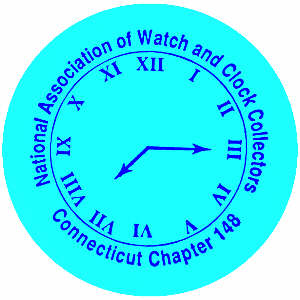
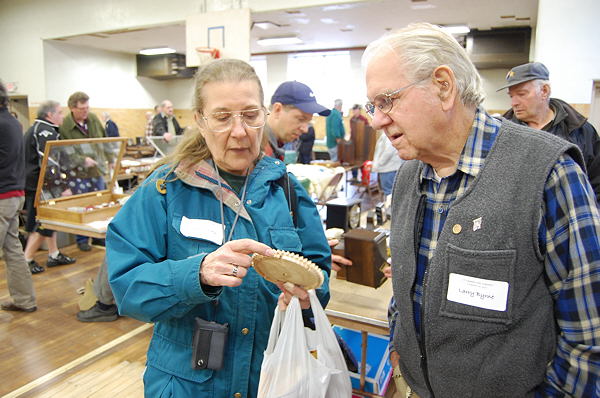
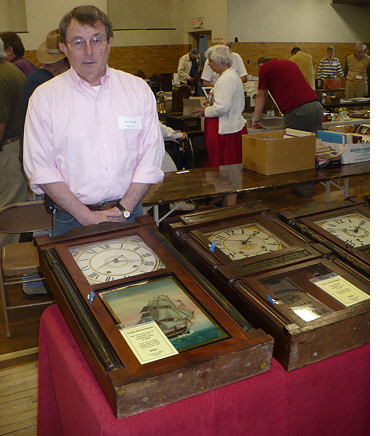 One tableholder who brought along some attractive circa 1830 wooden works clocks was Ian Roome. Ian is no stranger to the Chapter Marts and has been a collector and dealer for over 30 years. His clocks always seem to offer something special and are usually in quite nice condition.
One tableholder who brought along some attractive circa 1830 wooden works clocks was Ian Roome. Ian is no stranger to the Chapter Marts and has been a collector and dealer for over 30 years. His clocks always seem to offer something special and are usually in quite nice condition.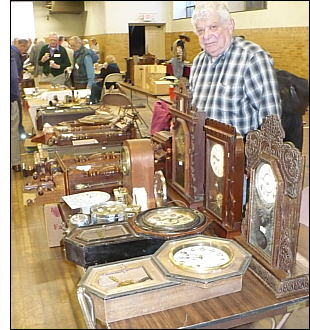 One table holder who is a regular at the mart is George Mednick (photo at right). On the surface there may seem to be nothing unusual about George's presence, until one realizes that he makes the trip to Connecticut every meeting from Long Island, NY. George makes the trip with fellow Long Islander, Jon Jacobi, who handles the tranportation. Oh yes, George gets up about 4:00 AM to meet Jon in order to make the 100+ mile trip to Newtown in time for the mart set-up. Such is one example of the dedicated members of Chapter 148.
One table holder who is a regular at the mart is George Mednick (photo at right). On the surface there may seem to be nothing unusual about George's presence, until one realizes that he makes the trip to Connecticut every meeting from Long Island, NY. George makes the trip with fellow Long Islander, Jon Jacobi, who handles the tranportation. Oh yes, George gets up about 4:00 AM to meet Jon in order to make the 100+ mile trip to Newtown in time for the mart set-up. Such is one example of the dedicated members of Chapter 148.